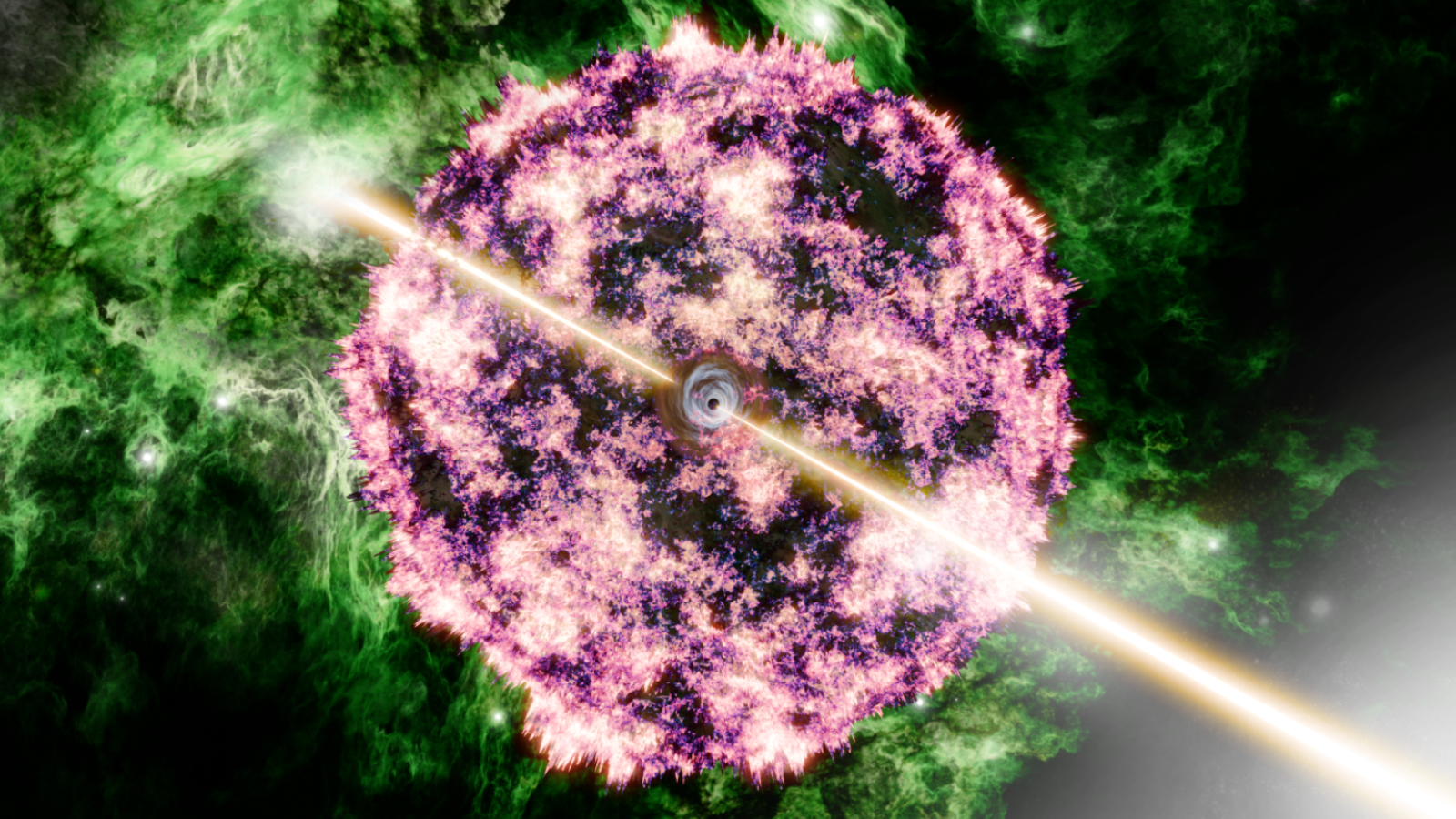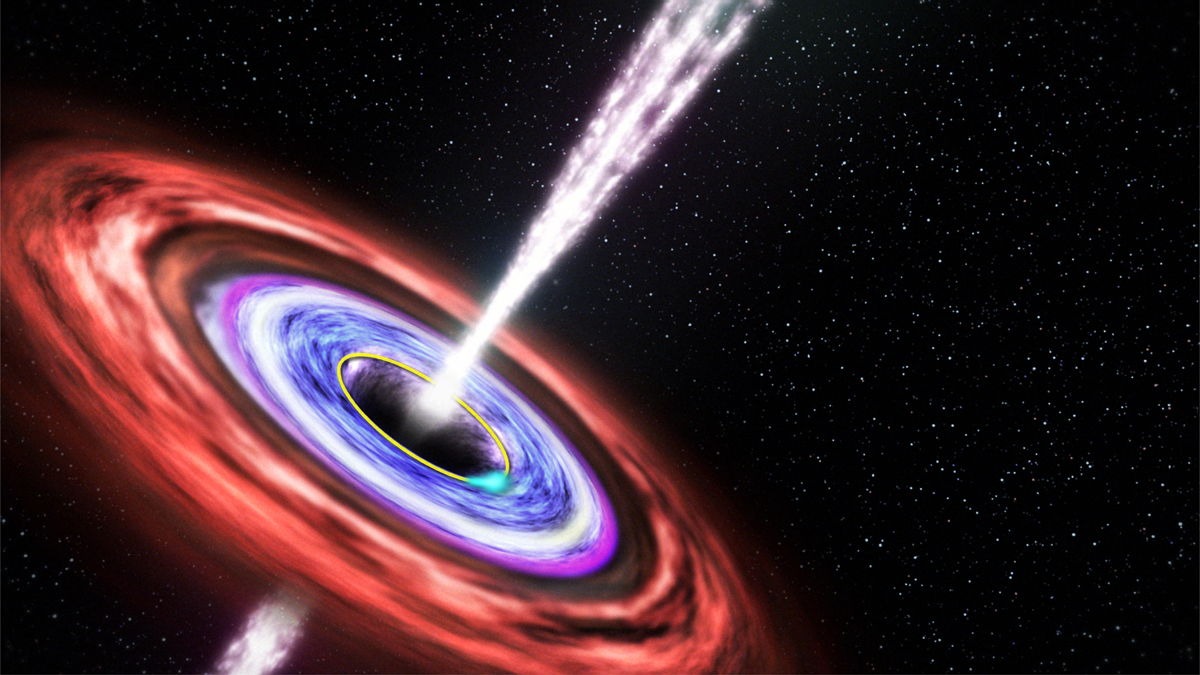Scientists unravel mysteries of gamma-ray bursts — the universe's most powerful explosions
"They allow us to see back to the earliest times that stars existed."

Scientists may be a step closer to discovering how gamma-ray bursts come to be some of the most powerful explosions in the known universe.
For context, a single gamma-ray burst, or GRB, can produce more energy in seconds than the sun will radiate in billions of years. Because of this power, scientists theorize that GRBs are created by some of the universe's most violent events. This includes things like supernova explosions that mark the deaths of massive stars and the collision and merger of two neutron stars, which are "dead" stars composed of the densest matter we know of, as well as outbursts from baby black holes.
Yet, aspects of these blasts remain shrouded in mystery, including the exact mechanism that launches a GRB and what exactly causes a "long" GRB that lasts more than 2 seconds versus a "short" GRB that lasts for less time.
One team of scientists from the University of Alabama in Huntsville, for instance, has been studying the light omissions of GRBs and how they change over time to better model these eruptions and finally crack their secrets.
Related: Giant gamma-ray flare from 'recently deceased' magnetar lights up Cigar Galaxy
"Despite being studied for over fifty years, the mechanisms by which GRBs produce light are still unknown, a great mystery of modern astrophysics," team leader Jon Hakkila, a scientist at the University of Alabama in Huntsville, said in a statement. "Understanding GRBs helps us understand some of the most rapid and powerful light-producing mechanisms that Nature employs.
"GRBs are so bright, they can be seen over the breadth of the universe, and — because light travels at a finite velocity — they allow us to see back to the earliest times that stars existed."
Get the Space.com Newsletter
Breaking space news, the latest updates on rocket launches, skywatching events and more!
Shining a light on GRBs
One of the primary reasons GRBs have remained so difficult to understand is that theoretical models to describe them have been unable to explain the behavior of their light curves, which are graphs that show how the light intensity of an object changes over time.
Further complicating the situation is the fact that no two GRB light curves are exactly the same, and the duration of the bursts can last from mere milliseconds to tens of minutes.
Hakkila and colleagues modeled GRBs as a series of energetic pulses, considering these pulses to serve as the basic units of GRB emission. "They indicate times when a GRB brightens and subsequently fades away. During the time a GRB pulse emits, it undergoes brightness variations that can sometimes occur on very short timescales," Hakkila said. "The strange thing about these variations is that they are reversible in the same way [palindrome] words like 'rotator' or 'kayak' are reversible."
The scientist added that it is very hard to understand how this reversibility can be the case because, unlike the letters in a word, time can only be read in one direction.
"The mechanism that produces light in a GRB pulse somehow produces a brightness pattern, then subsequently generates this same pattern in reverse order," he said. "That is pretty weird, and it makes GRBs unique."

The team focused on models of GRBs produced when black holes (recently formed by the death of a massive star) blast out jets of particles traveling at near-light, or "relativistic," speeds.
"In these models, the core of a dying massive star collapses to form a black hole, and material falling into the black hole is torn apart and redirected outward along two opposing beams or jets," Hakkila explains. "The jet material pointing in our direction is ejected outward at nearly the speed of light.
"Since the GRB is relatively short-lived, it has always been assumed that the jet remains pointing at us throughout the event. But the time-reversed pulse characteristics have been very hard to explain if they originate from within a nonmoving jet."
To explain the palindrome-like nature of GRB light curves, the team added lateral, or sideways motion, to relativistic jets blasting away from infant black holes.
"The idea of a laterally-moving jet provides a simple solution by which time-reversed GRB pulse structure can be explained," Hakkila continued. "As the jet crosses the line-of-sight, an observer will see the light produced first by one side of the jet, then the jet center, and finally the other side of the jet.
"The jet will brighten and then get fainter as the jet center crosses the line-of-sight, and radially-symmetric structure around the jet's core will be seen in reverse order as the jet gets fainter."
Hakkila added that, in this "ballistic model of GRBs," relativistic jets from black holes spray material in a way that is akin to a fire hose spraying water. As the jets acts like a fluid rather than a solid, he said an observer would see the entire jet as being curved and not straight.
"The motion of the nozzle causes light from different parts of the jet to reach us at different times, and this can be used to better understand the mechanism by which the jet produces light, as well as a laboratory for studying the effects of special relativity," he concluded.
The team's research was published on April 22 in The Astrophysical Journal.
Join our Space Forums to keep talking space on the latest missions, night sky and more! And if you have a news tip, correction or comment, let us know at: community@space.com.

Robert Lea is a science journalist in the U.K. whose articles have been published in Physics World, New Scientist, Astronomy Magazine, All About Space, Newsweek and ZME Science. He also writes about science communication for Elsevier and the European Journal of Physics. Rob holds a bachelor of science degree in physics and astronomy from the U.K.’s Open University. Follow him on Twitter @sciencef1rst.









